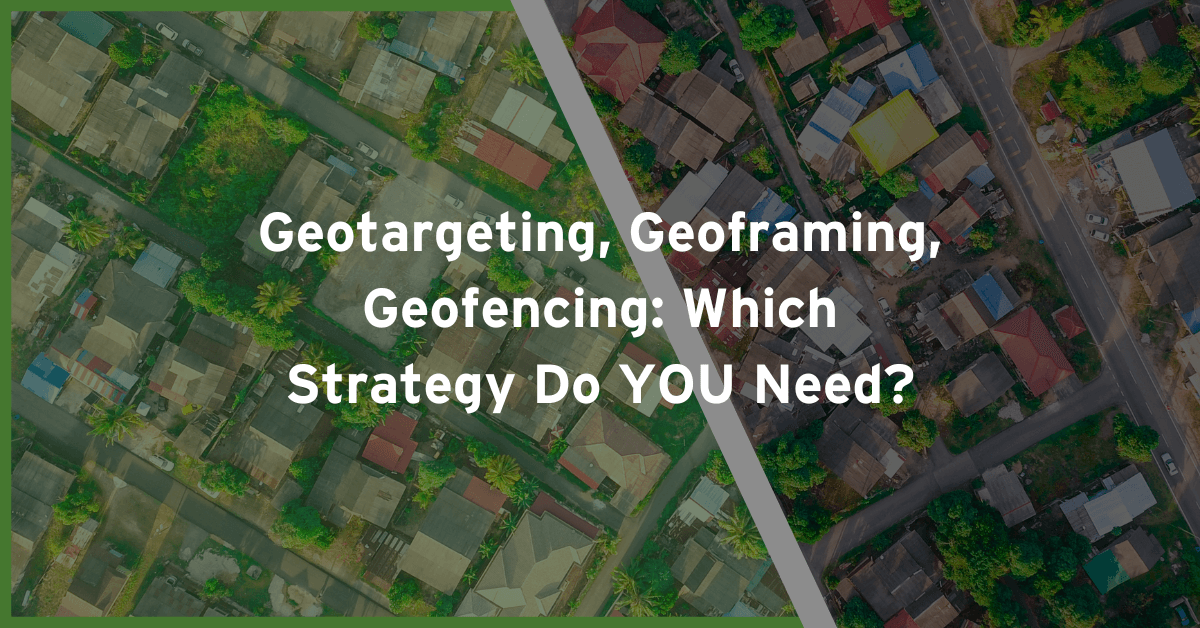What is geoframing? How is it different from geofencing and geo-targeting? Why is geoframing such an effective audience-building strategy? What is the best and easiest way to use this strategy to make your marketing successful?

What Is Geoframing?
We have all seen a message on our phone, asking us to allow a certain app to track our location. Precisely tracking our location is a common capability of modern phones.
Likely you’d want medical personnel to locate and rescue you in an emergency. However, consumers happily allow their location to be tracked for many other purposes – everything from shopping apps with reward points to apps allowing friends to locate each other.
The terms of service that users agree to with these apps allow a variety of tracking methods for marketing purposes.
Imagine drawing an area on a map and then tracking the cell phones that entered that area over a specific period of time in the recent past. This is exactly how geoframing works.
What Is The Different Between Geoframing, Geofencing, and Geo-Targeting?
Geofencing uses cell phone towers to determine where a person is right now. Think of those action movies where law enforcement tracks the bad guy’s cell phone.
While this technology certainly has its place, it raised a lot of legal concerns when marketers started using it. Like geoframing, it also tells you which devices are in a specific area.
Many in the marketing world were excited about geofencing when it first appeared. Yet the concerns about this method have held some back from using it. Sadly, some people, without knowing the difference between the two, have dismissed geoframing because of confusing it with geofencing.
Many people are okay with you knowing they were interested in beauty products two weeks ago. Yet they may be hesitant for you to know where they are right now. Hopefully, you see now that geoframing is not the same as geofencing.
Geo-targeting is a broad term used for a lot of different methods of focusing on people in a specific location. For example, you could get a list of names and addresses of people in a specific zip code. This technology has been around for many years.
Geo-targeting, in its many forms, is still very useful. Yet we should not confuse it with the new, powerful, and specific method of geo-targeting that we call geoframing.
Why Is This So Valuable For Building A Highly Accurate Audience?
You’ve probably heard the phrase, “Marketing is targeting.” It’s a simple truth that the more specific you are when targeting your audience, the more successful your marketing will be. If you know your prospects’ behaviors, wants, and needs, you can put the right offers in front of them at the right time.
What Is The Best And Easiest Way To Use Geoframing?

The right marketing agency can help you use geoframing to build a great audience of buyers. How does this work?
Their technology will consider which areas are a “mobile-friendly location.” What does this mean? It’s possible your prospect simply moved through an area on their way somewhere else. Yet a mobile-friendly location is a place where a person will pull out their phone and take some action that indicates you should make them an offer.
Good geoframing also looks at population density. How does the number of cell phones (people) that went through an area compare with the number of people expected in that area? Even in a rural town, geoframing can tell you whether everyone eats at Joe’s Diner or not.
The right marketer will also be careful to examine business density or the surrounding businesses. This will help you draw lines on the map in the right places so you get a better picture of your prospects. Otherwise, the people you thought were interested in a certain clothing store could be shopping next door for pet supplies.
Doing geoframing properly also examines customer movement carefully. For example, does a store have dedicated parking? If not, where will people park when they go to a certain location?
An Example of Geoframing In Action
Suppose you selected a specific restaurant on a map with geoframing. In a 3-month time frame, you find that 782 people went to that restaurant and used the restaurant’s app. However, without selecting an additional area of the parking lot, you would miss out on the 993 people who were using their phones to navigate to the same restaurant but didn’t use the restaurant’s app.
You can also use geoframing to give you what is called “attribution reporting.” For example, if you are the owner of that restaurant, no doubt you’d like to have the attribution report that tells you that 88% of the people targeted had responded to coupon B, whereas only 31% returned to the store to use coupon A.
What Geoframing Means For You
Doing geoframing the right way means watching the right devices and getting a much better picture of your prospects and learning exactly how you can target them.
We have years of experience helping companies use geoframing to make their marketing successful. We also enjoy making this technology usable by as many people as possible. How can we help you?
Digital Audiences are kind of a specialty of ours. To learn more about digitally targeting your customers and potential customers,





